#hong kongese
Text

#Tamio#Tamio artworks#Jamie Siu#Hong Kongese#SF6#Street fighter 6#loose hair#Hair down#Hair out#Official Capcom art#Capcom#Official art#Benpatsu hairstyle#Zui Quan practitioner#Stephen Fu#Hong Konger#Hong Kongan
380 notes
·
View notes
Text
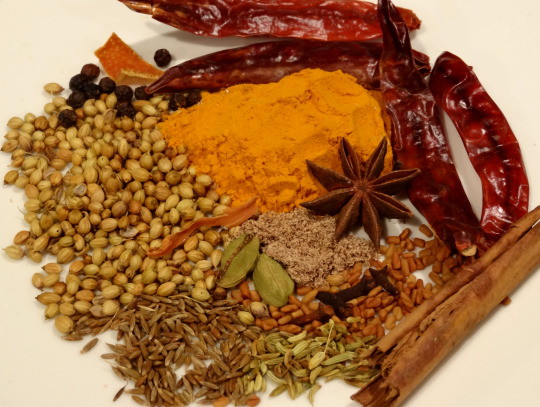
[ID: A plate of whole and ground spices including red chilis, Ceylon cinnamon, coriander seeds, and star anise. End ID]
新加坡咖哩粉 / Xinjiapo gali fen / Curry powder Singapura (Singapore curry powder)
Singapore curry powder, or gali fen ("gali" from the English "curry"), is a spice blend that was inspired by British Madras curry powder, but grew to incorporate Chinese spices and aromatics. It is representative of the culinary culture of Singapore, which incorporates influence from Chinese, Indian, Thai, Malay, and Indonesian cuisines.
This blend is used in “Singapore” curry fried noodles (actually a Hong Kongese dish) and in other Chinese curry dishes including chicken curry (新加坡式咖喱鸡), beef brisket curry (咖喱牛腩饭), curry soup noodles, and vegetable curries. It is also a popular choice for marinating meat and seafood.
Curry powder Singapura starts from a base of dried red chilis, and is rounded out with earthy spices including turmeric, coriander, cumin, and fenugreek. Warming spices such as nutmeg, mace, cinnamon, and cloves are often also included. Chinese influence sometimes appears in the form of chenpi (dried mandarin orange peel), Sichuan peppercorn, dried radish, liquorice root, star anise, and dried ginger.
Recipe under the cut!
Patreon | Tip jar
Makes about 1/3 cup.
Ingredients:
2 Tbsp (17.4g) ground turmeric / 薑黃
10 dry red chilis (11g; adjust to taste)
2 Tbsp (8g) coriander seeds / 芫茜
1 tsp (3.6g) fenugreek seeds (optional)
1 tsp (2.5g) cumin seeds / 小茴香種子
1 tsp (2g) fennel seeds / 谷茴
1 tsp (2g) ground ginger (optional)
1/2 tsp (1.6g) black peppercorns
1 inch (1.5g) Ceylon cinnamon / 桂皮
1 pod (1.4g) star anise / 八角
1g liquorice root / gan cao / 甘草 (optional)
1g chenpi / 陳皮(optional)
1g cao guo / tsao ko / 草果 / Chinese black cardamom, freshly grated (optional)
4 (1g) green cardamom pods
1/2 tsp freshly grated nutmeg / 玉果 (1/4 tsp preground; .5g)
1/4 tsp (7; .4g) cloves
2 blades mace (.2g; optional)
Liquorice root, chenpi, and cao guo may be found at an east Asian or Chinese grocery store, but may need to be purchased online. Many homemade versions of this spice blend do not include these spices.
Hong Kong curries tend to be relatively mild and sweet, including a lot of turmeric and cinnamon relative to the amount of chili and pungent spices. You should adjust the heat, sweetness, and pungency of the blend to your taste.
Instructions:
1. For a less spicy curry powder, you may choose to break open the chilis and remove all or some of their seeds.
2. Roughly crush star anise, cinnamon, nutmeg, and cardamom pods in a mortar and pestle or with the flat of a knife. In a small, dry skillet, toast whole spices (coriander, fenugreek, cumin, black pepper, cinnamon, fennel, star anise, nutmeg, cardamom, Sichuan peppercorn, cloves, and mace) one at a time until each is fragrant. Set aside and allow to cool.
Spices are toasted one at a time so that smaller spices don't burn before larger ones are fully fragrant. Sometimes, I'll toast larger spices (such as cloves and cardamom pods) together, and then toast smaller seeds (such as cumin) together, to speed up the process.
3. Remove pan from heat. Toast ground spices (turmeric, and anything else you used a ground version of) for 30 seconds, stirring constantly, and remove from the skillet.
4. Grind liquorice root in a spice mill or coffee grinder until as fine as possible, then pass it through a sieve to remove larger pieces. Return those pieces to the mill and grind again. This is done separately because liquorice root can be tough to grind!
5. Grind all spices in a spice mill until fine. Pass through a sieve. Store in an airtight container in a cool, dry place.
72 notes
·
View notes
Text


Qipao | c.1950s | Hong Kongese
18 notes
·
View notes
Text

Twitchcon collab art
#Jamie#Hong Kongese#Luke Sullivan#American#Shunsuke Takeuchi#Stephen Fu#Aleks Le#Tomoaki Maeno#Tamio artworks#Tamio
71 notes
·
View notes
Text

#xodiac sing#mak chun sing#xodiac#hong kongese#hot guy#male idols#black tank top#asian guys#born 2002
11 notes
·
View notes
Photo

9 notes
·
View notes
Text

The Butterfly Murders (1979)
27 notes
·
View notes
Text
The Side Look of a Barcelonese #1 986 : Night Street Jordan © Shojiroh Yamagata aka Zirosou :
The Side Look of a Barcelonese #1 986 :
Night Street Jordan © Shojiroh Yamagata aka Zirosou :
#shojiroh yamagata#zirosou#the side look of a barcelonese#choice of the day of YWAMag#choice of the day of the mag#art#night shots#architecture#moody images#emotions#masters on tumblr#perfections#gifts#decay#street photography#hong kongese photographers#japanese photographers#masterpieces#yes we are magazine#composition#contemporary art#visual poetry#visual art#artists on tumblr#photographers on tumblr#original photography
4 notes
·
View notes
Text

"Dyal Thak" (changing lives of Tibetian nomads) - by Kin Coedel, Hong Kongese
262 notes
·
View notes
Text
2023 BL wrapped
@khaotunq tagged me!! tysm ❤️❤️
Welcome to your 2023 BL Wrapped! Let's see how your year went...
You watched a total of 48 QLs.
You watched 409 episodes total with an average length of 37 minutes.
All of this amounted to a total watchtime of 247 hours and 34 minutes or a bit over 10 days.
Your busiest month was August with 12 shows finished.
Your top country was Thailand with a whopping 54,17% of the dramas being produced there. Here‘s your full breakdown:
Thai: 26 = 54,17%
Korean: 10 = 20,83%
Japanese: 8 = 16,67%
Taiwanese: 2 = 4,17%
Chinese: 1 = 2,08%
Hong Kongese: 1 = 2,08%
30 shows you watched were released in 2023. You caught up on 13 dramas from 2022 and 5 from previous years.
Your overall BL mood was eager. You've been gone from the scene for a while and were excited to fully get back into it.
The acting pair you couldn’t get enough of was FirstKhao. Their performance in The Eclipse and Only Friends captivated you to the point of changing your url.
Your most listened to OST is Your World, My World by Khaotung Thanawat and First Kanaphan for Our Skyy 2.
You giggled and yelled at your screen approximately 78* times and had 132* mental breakdowns.
Thank you for reading! Stay tuned for my full recap to find out about my favourites of the year and let me know if you wanna be tagged for it ☺️
idk who hasn't done this yet so I'm just gonna tag a bunch of ppl 🫶
@firstmix @blneobin @maxescheibechlinichacheli @first-kanaphan @gunsatthaphan @itsallaboutbl @ithappensoffstage @bunnakit @jeffsatur @veemark @omegaphobe @bfwangji @akkpipitphattana @gayshrug
*rough estimates based on zero evidence
11 notes
·
View notes
Text

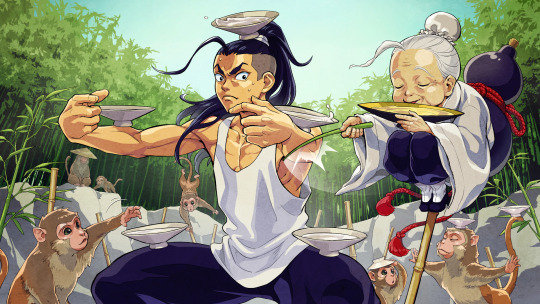


The bonds with Jamie
#Li-Fen#street fighter series#street fighter 6#capcom#Jamie Siu#Hong Kongese#Panda girl#Master-Student bond levels#SF6#Teen Li-Fen#NPCs#Kid Jamie Siu#Yang (Street fighter series)#Yun#the twin dragons#Panda animal motif#Stephen Fu#N.P.C.#Hong Konger
210 notes
·
View notes
Text
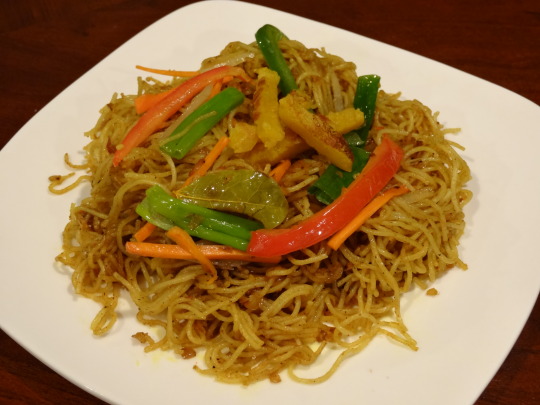
星洲炒米粉 / Xing zhou chao mei fun (Singapore noodles)
This dish fries steamed noodles and assorted vegetables in a mildly spicy curry paste, made from a bespoke curry powder and a blend of fresh aromatics. The result is a crispy, chewy, complex, warming stir-fry with notes of turmeric, liquorice root, and cinnamon.
Though this dish is referred to as "Singapore noodles," vermicelli dishes common in Singapore do not include curry powder! These "Singapore" noodles in fact originated in Hong Kong 茶餐廳 (cha chaan teng; Western-influenced cafés), and gained popularity between the 1940s and 60s. They combine British influence (in the form of curry powder) with the rice noodles common in Chinese, Malay, and Indian cooking; the reference to Singapore is perhaps a nod to the cosmopolitan, "exotic" atmosphere of these cafés.
This is a vegan version of a dish that often also includes shrimp, char siu, or chicken. Instructions for a vegan version of the typical sliced fried egg topping are included.
Recipe under the cut!
Patreon | Tip jar
Serves 3-4.
Ingredients:
For the dish:
200g vermicelli rice noodles (bee hoon / mi fen; 米粉)
4 green onions, greens and whites separated
1/2 medium yellow onion, thinly sliced
1 medium (50g) julienned red mild chili (such as aji dulce), or 1/4 medium red bell pepper
1 medium (50g) julienned green mild chili, or 1/4 medium green bell pepper
1 bunch yellow chives
Small handful bean sprouts
3-inch piece (40g) carrot, julienned
1 tsp table salt, or to taste
Large pinch MSG (optional)
Rice vermicelli (also known as bee hoon / bihun, mee hoon / mihun, or mi fen) are long, fine rice noodles. They should not be confused with semolina vermicelli. They may be purchased at an east or southeast Asian grocery store; Chinese, Vietnamese, or Thai rice vermicelli will all work. I used Hai Ca Vang rice vermicelli, which I like in this dish for how well they stand up to stir-frying, and the chewy bite they give to the final dish.
Yellow chives are simply chives that have less color because they are grown out of the sun. They may be found in a Chinese grocery store; if you can't get your hands on any, omit them or substitute more bean sprouts.
For the curry paste:
4 tsp curry powder Singapura, or to taste
3 cloves garlic
4 Thai shallots, or 1 Western shallot
1-inch chunk (10g) ginger
1/4 medium yellow onion
White of 1 stalk lemongrass (optional)
1 bay leaf (optional)
Some versions of Singapore noodles are flavored entirely with curry powder, or (if a spicier curry powder is being used) with a mix of curry powder and turmeric; home cooks tend to include less curry powder or paste than restaurants do. You could decrease the amount of curry powder down to about a teaspoon for a home cook version of this dish. If you aren't making your own, Singapore curry powder (咖哩粉) can be purchased online from specialty spice retailers, or from a Hong Kongese brand such as Koon Yick Wah Kee; you could also substitute another mild, sweet curry powder, such as Japanese curry powder (S&B is a popular brand).
You could skip prepping the aromatics as well by purchasing a jar of ready-made Chinese curry paste (咖哩醬) from a brand such as Koon Yick Wah Kee (whose blend consists of curry powder hydrated with white vinegar and soybean oil); Malaysian curry paste would be a good substitute. Some recipes make a quick homemade curry paste by combining curry powder with salt (1 tsp), sugar (1 tsp), oyster sauce (1 Tbsp), water (2 Tbsp), and sometimes chili sauce, and add this sauce to the noodles as they are fried. I prefer versions of the dish that add fresh aromatics, though—I think they round out the curry powder by providing a flavorful base for it. You can experiment until you get the flavor and texture you prefer.
For the egg:
1/4 cup (60mL) coconut milk, or water
1/2 tsp ground turmeric
1/4 - 1/3 tsp kala namak (black salt)
1/4 tsp ground white pepper (optional)
1/2 tsp Liaojiu (Chinese cooking wine)
Liaojiu will likely be labelled "Shaoxing wine" in English. For an alcohol-free version, use ume plum vinegar or apple cider vinegar. The wine is used to flavor and cut the 'egginess' of the eggs.
This recipe usually calls for eggs, liaojiu, and salt. The turmeric and white pepper add flavor and color; the kala namak provides an eggy taste.
Instructions:
1. Prepare the aromatics. Peel and chop the garlic; mince the onion and shallots; scrub and mince the ginger (there's no need to peel it). Divide the whites of the green onions from the greens, and mince the whites.
Pull away any tough outer leaves of lemongrass. Separate the yellow / white section from the green, and cut off the root end. Reserve the green to flavor soup stocks. Thinly slice the white of the lemongrass widthwise, then pass the knife through for another few minutes to mince very thoroughly.

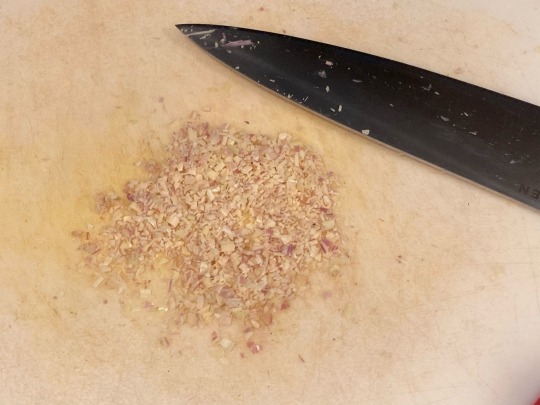
For a "saucier" noodle dish, pulverize the aromatics in a mortar and pestle or a blender rather than mincing them.
2. Prepare the vegetables. Cut peppers into a thin julienne; julienne the carrots; thinly slice the onion. Cut the greens of green onions, bean sprouts, and chives into 1 1/2 or 2” pieces.
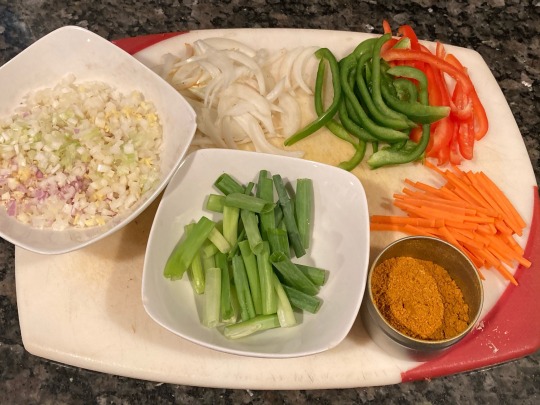
3. Cook the noodles. Soak noodles in just-boiled water for about 90 seconds, or until they break when pinched firmly. Depending on the thickness of your noodles, they may need as much as 2-3 minutes.
Drain the noodles, but don’t rinse them. Spread them out on a baking sheet and cover to allow to steam for 10 minutes. With oiled hands, gently pull apart and untangle the noodles. Cut them in a few places with kitchen scissors to make stir-frying easier.
4. Cook the egg garnish. Whisk all ingredients for the egg together in a small bowl. Heat a wok over medium heat for several minutes, then add in a couple teaspoons of oil and swirl to coat the surface of the wok. Pour ‘egg’ into the bottom of the wok, then lower heat to low and allow to cook until darkened and solidified on top. Flip and cook the other side on medium-high until browned in places. Remove from wok and thinly slice.
5. Cook the vegetables. Heat wok on high for several minutes. Add in a couple teaspoons of oil and swirl to coat. Fry sliced onions, agitating often, for about 30 seconds; add carrots and fry another 30 seconds. Add peppers and cook for another 20-30 seconds. Remove from wok.
Cook chives or bean sprouts for 30 seconds to a minute, until slightly wilted, and remove.
6. Make the curry paste. Add another couple teaspoons of oil to the wok. Fry the aromatics (whether minced or pulverized) and bay leaf, stirring often, until fragrant, about 2 minutes. Lower heat to low, then add the curry powder and stir. Immediately add another couple teaspoons of oil, or enough to create a bit of sauce (the amount will vary based on how much curry powder you've added).
If you're using pre-made curry paste, just fry it for 30 seconds or a minute until fragrant. If you're using a mix of vegetarian oyster sauce, water, salt, and sugar, skip this step.
7. Fry the noodles. Raise the heat to medium-high. Add the noodles and stir to coat evenly. Allow noodles to sit for a minute or two, then flip with chopsticks or tongs and allow to fry again. This will help the noodles to fry and brown.
Do this a few times until noodles are evenly toasted, 4-5 minutes. Add salt and MSG (or oyster sauce mixture) and stir to coat. Add in vegetables, egg, and green onions and cook for another minute until green onions are wilted.
66 notes
·
View notes
Text
I've been on a bit of a curry powder kick with my recipes lately I think. curry powder is sooo interesting as a subject of study because of how much potential for localisation there is; the process of creating recipes for different regional blends of curry powder is really making me think about my philosophy with adapting dishes.
like, plenty of home cooks in China & Hong Kong will actually use imported curry powder from India or Malaysia to make Chinese curry, because they're "aiming at" a "foreign" flavor profile that was originally inspired by Indian cuisine (with this image of Indian cuisine being itself a result of colonisation, an innovation aimed at making the ~flavours of India~ more accessible to the English home cook in the 18th and 19th centuries—but Indian companies to-day do export "curry powder" blends to other English-speaking regions that they label "authentic" &c. &c.).
but this wouldn't be very interesting to me! I'm interested in and "aiming at" a specifically Hong Kongese adaptation of curry powder, and therefore I'm going to want to include as many Chinese ingredients as I can find 'attested' in Hong Kongese curry powder recipes (in my research into the spices used in commercial curry powder blends made and packaged in Hong Kong; home cook YouTube videos and interviews with restaurant owners based in Hong Kong; &c.). I'm never ad-libbing (i.e., adding in spices or aromatics that I don't see 'attested' in whatever local blends that I can find a trace of online), and I try to make the proportion of spices that I include in a blend basically adhere to the average of what I see in the recipes I consult (& the commercial blends, which don't list out proportions but do at least have some ingredients listed and organised in order of weight)—
but I still have my own tendencies that I'm interested in indulging (e.g., localised over generic; more over less; pungent over mild), and I'm able to fiddle around with all of those variables to produce a blend that is itself attested nowhere else, though each of its component ingredients can be traced back. so my recipe for Xinjiapo gali fen jumps at all of the 'Chinese' ingredients that Koon Yick Wah Kee includes (Sichuan peppercorns, Chinese black cardamom), but also includes more 'Indian' spices that other recipes include, but their's doesn't (e.g. green cardamom, fenugreek).
(as a side note for anyone who speaks French—on peut constater que the list of ingredients has been machine-translated from Chinese to English and thence to French, based on the fact that "star anise" has been rendered "tenez le primier rôle l'anis". other translation issues: what is listed as "dried parsley" in English [芫茜] is probably actually coriander seeds.)
25 notes
·
View notes
Text
me: haha isn't it funny how I just fuckin Won't block people, even if they're anons trolling me, because that just seems so final lol. It's a bit silly I know but I'm a hoarder like that.
a post on my dash: "taiwanese" "Hong kongese" bitch just say you're Chinese
me:

#BLOCKED BLOCKED BLOCKED#BLOCKBLOCKBLOCKBLOCK#NONE OF YOU ARE FREE OF SIN#IN THIS HOUSE WE RESPECT TAIWAN AND HONG KONG#not in a hetalia way but in a I'll Kill You way
36 notes
·
View notes
Text
I transcribed most of the parts that mention Faye.
Who is Faye Wong?
Earlier in Faye Wong's career, people wanted her to be anything but herself.
Because she was from the Mainland, they tried to force her to have this Hong Kong personality because they were worried that Hong Kong audiences wouldn't accept someone who was from the Mainland.
Wong's handlers gave her an anglicized name: Shirley Wong
She didn't enjoy it. She felt forced into a fake version of herself.
But none of that apparently bothered Wong Kar-wai. Because he saw an edge that her handlers had been trying to sand away.
He was very much taken with Faye Wong who's an interesting figure because she was a Mainlander and she had a particular aura that he thought was interesting. She seemed cooler than the people in Hong Kong cause there's something kinda otherworldly about her. And in fact, she seemed cooler.
Cooler than even the Hong Kongese who think of themselves as the coolest.
Yeah, you look at her and you think 'oh that's the cool person'.
He [Wong Kar-wai] could see it and that's part of his gift.
Faye Wong with the fake persona she hated was figuring out what was next for her.
She disappeared for some time and she went to study in New York.
She roamed The Big Apple for a few months and said: 'I saw so many strange, confident looking people. They didn't care what other people thought of them.'
And then when she came back, she became a different person.
In 1993, she dropped the LP, "100,000 Whys" doing covers of songs from Western alt rockers like Tori Amos and throwing in some killer pop originals like this one called 'Flow Not Fly'.
The Hong Kong kids fell in love with her.
She was the huge rising star because it was so cool to be a fan of Faye Wong.
She was like the Nirvana of that moment.
When you mention Nirvana, I remember the way she dressed at the time. She was wearing all these grungy style clothes. And there was no internet at that time so I had no idea about Nirvana or the grunge music scene. And people were commenting 'How come Faye Wong dresses like this?'. They're not glamorous outfits that people would be expecting a Cantopop star to be wearing.
You know a lot of people obviously try to entertain and that's great. But with Faye Wong, you had to come to her. She just did her thing. She couldn't be put in a box.
In other words, Hong Kongers finally saw what Wong Kar-wai had seen years before: a Mainlander who out-cooled them all. Something totally modern which made her and her music the perfect fit for the director's next movie - a snapshot of modern Hong Kong in 1994.
Chungking Express
Story #2 featured a food server on hip Hong Kong Island played by Faye Wong, named Faye, and was like real life Faye in every way the music audience would probably recognize.
The movie-Faye dreams of leaving Hong Kong for the West. She's constantly blasting The Mamas and the Papas 'California Dreamin' like Faye Wong, movie-Faye does leave for the West. And like Faye Wong, movie-Faye also comes back changed.
Now she's an airline attendant and she's come to pay a visit to a guy she was obsessed with but never quite dated played by Tony Leung.
"WHERE DO YOU WANT TO GO?" she asks him.
"WHEREVER YOU WANT TO TAKE ME." says Tony.
Will they stay in Hong Kong? Will they go? Instead of telling us, Wong Kar-wai smash cuts to the end credits, accompanied by Faye Wong's cover of a different song about dreaming.
Her version of The Cranberries tune is called 'Dream Lover'. It's as joyful as the original with Cantonese lyrics that add a hint of trepidation. They're about waiting to fall into a long kiss with an enticing stranger.
It could be movie-Faye singing to Tony.
'Dream Lover' came out a month before the movie debuted. The tune was already a smash. But now the tune was about to get bigger.
Chungking Express Goes Global
And the other thing international audiences took from the film? Faye Wong.
In that great sequence when she's at the snack bar and she's dancing to California Dreamin', the first time it ever played in North America at The Toronto Film Festival, after she finished dancing, the crowd applauded because it was such a magical sequence. And people came out thinking: 'Who is that woman?'
That's the other thing about Faye Wong. Hardened film critics came out thinking 'Who was that?'
For sure, Chungking Express was a great introduction of her to a much bigger international stage. She became quite popular in Japan thanks to the film. And so she did quite a few concerts in Japan and she did the themesong of Final Fantasy the video game. So she was that big.
Noel Hogan of The Cranberries
And as for 'Dreams', after Faye Wong's cover blew up in Hong Kong in 1994, Noel Hogan and his band had some inkling it was out there.
"We knew it happened and kinda forgot about it because we were so busy touring. But then bit by bit you'd kinda hear that 'Dreams' had taken off in this country and that country . But it really really didn't hit until we went to Hong Kong and later to China that we saw the full impact of it and how big it was."
"We were absolutely shocked."
Turns out Faye Wong had popularized 'Dreams' and the band who'd written it.
Emma Lee Moss (on her cover)
"It's just such a crowd-pleaser. People are like 'oh i know that song'. It takes them awhile to figure out what it is. Unless you're in Hong Kong, in which they know exactly what you're doing."
"Everywhere you go, there's someone who loves Faye Wong. I played in China and I couldn't communicate with anyone because my Mandarin was so terrible. But the moment we started talking about Faye Wong, we're talking in Faye Wong song titles. That's how we were communicating."
An Irish kid writes a song in his room. A Mainlander sings it to Hong Kong. Then a movie sends her music everywhere.
(SOURCE: MUBI PODCAST)
20 notes
·
View notes
Text



1980s Hong Kongese wedding dress of my dreams
#which I did NOT buy (expensive) and did NOT run off with (large and distinctive). woe betide me#costume
2 notes
·
View notes